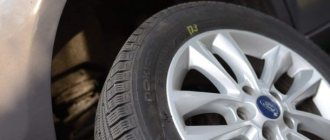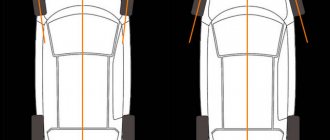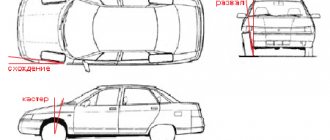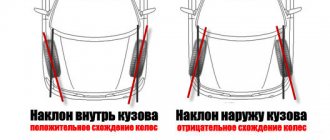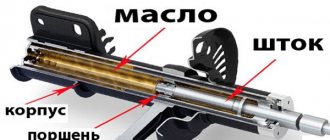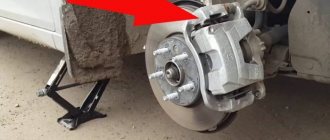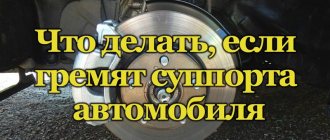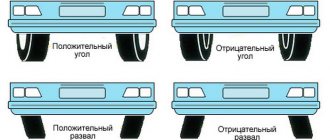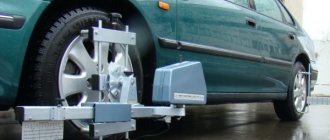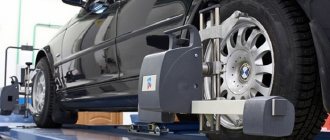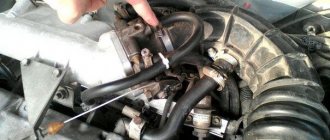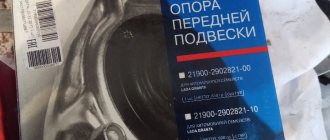The chassis of a vehicle is rightfully considered a complex unit where the elements are connected to each other. The suspension provides a comfortable ride and affects the safety of the car. If the car's suspension system is capricious, it negatively affects handling. The car handles worse on the road and loses maneuverability.
The problems mentioned above fully relate to the car's depreciation system. Today, our goal is to find out whether it is necessary to do a wheel alignment after replacing shock absorbers.
When you don't need to do a wheel alignment
No matter what you repair, the service station will tell you to do a alignment. They will argue that if you don’t adjust it, the ride will be uncomfortable and almost dangerous. Don't listen. Often, replacing components does not affect the wheel tilt adjustment and there is no need to pay for additional work. Read and remember whether it is necessary to do an alignment after replacing silent blocks, shock absorbers and wheels. You won't be deceived anymore.
Tire replacement
The misconception that after replacing wheels you need to do an alignment is spread by the service station workers themselves. But seriously, changing tires in the standard way does not affect components that are associated with suspension settings.
After replacing the wheels, wheel alignment is not necessary.
If your car pulls to the side with new tires, check the tire wear level.
Replacing shock absorbers and silent blocks
To replace shock absorbers, steering rods and ball joints are not unscrewed. Therefore, to replace the struts, there is no need to do a camber. Although it can be adjusted, there will be no harm.
It's a little more complicated with silent blocks. See if their replacement affects components that affect toe-in - rods, tie rods, ball joints. If it affects you, adjust it, if not, don’t touch it. Change the silent blocks in the struts without adjusting the camber - when installing shock absorbers, the steering elements are not touched.
Replacing stabilizers
The situation is similar to the previous one - when the stabilizers are changed, the main suspension components are not affected. Therefore, after repairing the stabilizers, do not buy a wheel alignment - value your time and money.
Design and operation of racks
As a rule, a stand is a rod 5.20 cm long. There are hinges at both ends that provide a movable connection. These can be either two ball joints, or a joint and a stabilizer bushing, or two bushings, or a joint on one side and a thread on the other. They are usually welded to the rod at a right or close angle.
In the place where the tip adjoins the metal rod there is a thinning (“neck”). It serves as a kind of fuse. If the mechanism experiences extreme loads, its body will break in this very place. Otherwise, the strut may break anywhere, breaking through the bottom of the car and causing harm to passengers or other mechanisms.
Articulating stand device
The most popular currently are racks using a ball joint . Its design consists of two parts - a steel ball pin and a plastic seat with temperature-dynamic lubrication. The finger is pressed onto the top with a plastic or metal cap.
The hinge joints are always protected with sealed boots and lubricant. It ensures smoother operation of the mechanism and also increases its service life. The lubricant is frost-resistant, ensuring normal operation of the vehicle's chassis system in winter.
To better understand the principle of operation of the rack, you need to remember that it is not rigidly connected to the stabilizer, providing limited movement of the elements combined into the mechanism. When turning a car at speed, its natural roll occurs. In this case, the same forces act on the body, and on the suspension - directed in the opposite direction. If they are not compensated for, there is a risk of breakage of the associated elements - the stabilizer and the hub eye. Thus, the stabilizer link is a damper that receives and dampens large multidirectional forces. However, during operation, under the influence of the mentioned forces, a gradual destruction of the hinge joints occurs. As a result, the racks become unusable.
In what cases is it not worth adjusting the wheel alignment?
This operation itself, if it is carried out in a good car service center and with high-quality equipment, is not so little, especially if the adjustment is to be made on an expensive foreign car. Therefore, no one wants to pay money in vain.
Seasonal tire change
Roughly speaking, the wheels are not part of the suspension: rather, they are attachments. Someone may object: they say, they changed the tires, and the car began to pull to the side. This happens due to uneven tread wear: for example, if you installed used tires and did not properly inspect them.
Replacing shock absorbers and stabilizers
If the suspension has been repaired, then as for the second parts, they do not affect the alignment in any way. The same can be said about shock absorbers if they need to be replaced. In most cases, they are installed at the front inside the spring and can be removed by unscrewing two or three (depending on the model) bolts.
A few words about safety
More than the suspension, the only thing that affects driving safety is the brakes. To avoid getting into trouble, monitor their condition - change the pads on time and constantly check the amount of brake fluid. After replacing the pads, you need to bleed the brakes - this is not the law, but it’s safer and you’ll have peace of mind.
Keep an eye on the important components of the car - suspension, steering, brakes. A timely visit to the specialist will save you from many problems and costs.
When you feel that the car is not behaving normally, contact the station immediately, even if it is just a suspicion. It’s better to play it safe – it will get worse later. Timely maintenance will save you from accidents and the costs of future repairs.
If you find an error, please select a piece of text and press Ctrl+Enter.
Source
Do I need to do a wheel alignment after replacing ball joints?
Many motorists are familiar with the concept of “wheel alignment,” and most likely most of you have at least once driven your car to a stand to check the alignment angles of the front wheels. Ideally, of course, this procedure should be performed after each repair of the chassis, but for some reason we are used to doing everything at the last moment, until the rubber begins to be eaten away on one side.
In many repair and maintenance manuals for modern cars, you can find information that after replacing the steering tips, it is necessary to check the wheel alignment. But it’s clear about steering wheels, but what about ball joints, because for many car enthusiasts this issue is of greater importance?
To do it or not: that is the question
Regarding the tie rod ends, it is worth saying that they are the ones responsible for the toe-in of the front wheels; therefore, when installing new ones, they must be placed at the same distance along the steering rod as the previous ones. This can be achieved either by counting the turns when removing the tip, or by measuring the thread with a caliper.
But regarding the ball joint, everything is not as clear as it might seem. On the one hand, it does not in any way affect the change in the angle of the wheels, especially if you install the same support instead of the old one. The dimensions are the same, the fit is the same, there are no adjustment threads, and there seems to be nothing to be afraid of.
But in real life things are a little different. Now we will look at two main reasons why it is still worth performing a wheel alignment after replacing the ball joints.
1. Firstly, the previous wheel alignment procedure could have been performed on worn ball joints, and the angle was the same, but when you installed new supports, they began to “hold” the steering knuckle differently, and the angle could change.
2. Secondly, even if you pick up exactly the same support in the store as it was before: the same manufacturer, and even the batch number, the castings may differ from each other by even 1 mm, which leads to a change in the angle of the wheels when replacing an old support with a new one.
In practice, of course, both of these cases do not happen so often, but you must agree that it is better to pay 600-1000 rubles to a service station for checking the wheel alignment than to buy a new set of tires for several thousand rubles, and sometimes one cylinder can cost up to 10,000 rubles .
I hope that my experience in this area was useful to many. If so, subscribe to the channel and be sure to like each episode on the channel so as not to miss new interesting materials that come out here every day.
Thank you for your attention, and good luck on the roads.
- Second car for disassembly for RUB 5,500. Earnings amounted to 7700 rubles. Detailed analysis
- Volga GAZ-21. Friends are not for sale
- Car under 10,000 euros: a choice for everyone
Installation angles
All installation geometric angles are measured in degrees, with the exception of the toe angle, which is most often measured in millimeters in European countries.
Vehicle suspension parameters are measured from several angles:
- toe-in;
- camber (Gamber);
- caster;
- longitudinal angle;
- transverse angle;
- kingpin angle.
The main setting angles are the first three, that is, toe, camber and caster angles. Changing any of these angles significantly affects the geometric parameters of the wheels. In order to understand what a wheel alignment is, it is worth examining each corner separately in detail.
Toe-in
Toe-in is translated from English as wheel toe-in and generally has a positive meaning; traditionally, Subaru models have zero toe-in, and negative settings are used exclusively on sports racing cars.
Positive toe is considered when the front part of the tire is directed inward towards the longitudinal central axis of the car, and negative when it deviates outward. The deviation of this angle affects:
- for increased tire wear;
- handling when turning;
- vehicle rolling distance.
On rear-wheel drive vehicles, positive toe-in is considered to be within 1 to 2 millimeters, and on front-wheel drive vehicles, from 0 to 1.5 mm. The adjustment units are located on the steering rods.
Camber (Gamber)
The camber angle can be either positive or negative depending on the design features of the vehicle suspension. On rear-wheel drive vehicles, positive yaw deflections are usually used in the range from 0 to +1 degrees. Front-wheel drive vehicles generally have negative camber from 0 to -1 degrees. Significant deviations affect handling and contribute to wheel tread wear.
The main reasons for violation of the Gamber angle are:
When these malfunctions occur, the wheel begins to deviate towards negative camber, while the toe-in of the wheels changes, quite often the initial position of the steering wheel changes, the car is felt to pull away, and wear marks appear on the tread on one of the sides.
It is worth noting that not all cars, especially cars with MacPherson strut suspension, have adjustment units for this angle. On earlier models, eccentric bolts were installed on the lower arms or shock absorbers for adjustment. So, for example, on the VAZ 2108 model, the upper bolt securing the shock absorber strut to the axle is eccentric, which allows adjustment work. Gradually, the engineers abandoned this idea. Therefore, if the camber deviates from the factory parameters, the reason should be sought in the elements of the chassis or body geometry.
Caster
A very important and responsible angle, violation of the parameters of which leads to the car moving away from straight-line motion; in fact, the front axle of the car’s wheels shifts in relation to the rear axle. Caster stabilizes the vehicle's handling at high speeds and ensures that the steered wheels return to their original position when turning. The angle is always positive, and the higher it is, the more stable the car is at high speed. On ordinary cars the range is from two to five, and on sports cars the tilt reaches nine degrees or more.
Reasons for changing caster tilt may include:
- the lever is deformed due to hitting an obstacle;
- silent blocks destroyed;
- spring is broken;
- the shock absorber strut is deformed (MacPherson system);
- deformation of the front subframe or body.
Almost all SUVs have units that allow you to adjust the angles of the wheels, which are located at the point where the levers are attached. Two adjustment methods are used:
- eccentric bolts;
- adjusting plates or washers.
On the VAZ 2121 the unit is located on the upper arm; washers are used, by installing or removing which adjustment work is carried out. Imported SUVs have special eccentric bolts located on the lower or upper suspension arms.
Why do you need to do a wheel alignment?
Wheel alignment must be done in any case, since incorrect installation or its complete absence leads to very rapid wear of the tires and deterioration of vehicle controllability. Camber is the angle of the wheels to the road. Depending on the needs of the motorist, it can be either positive or negative. In the first case, the upper part of the wheel is tilted towards the center of the car by about 1.5 - 2 degrees. This camber is not desirable as it increases tire wear, but it also provides better traction. In most cases, positive camber is set.
Toe-in is the difference in distance, which is measured along the front and rear points of the wheels (discs) horizontally. It is measured in millimeters or degrees. It can also be positive. Negative and zero. Positive toe-in of the front wheels provides stable control at high speeds, but at the same time maneuverability, that is, steering, deteriorates. If the toe is negative, then it is easier to drive the car, since the reaction of the wheels to the rotation of the steering wheel improves. However, in this case, you will have to change the tires often, since they wear out very quickly on damaged roads. For the rear wheels the situation is almost the same. The best option would be to set the wheel toe to zero. This will keep both handling and tire longevity in balance. Normal wheel geometry angles provide the vehicle with fuel efficiency, easier handling and maneuverability, stability and a reduced tendency to depreciation and rollover.
It is also important to know the first signs of an unadjusted wheel alignment:
- The car drives to the right or left;
- Increased and uneven tire wear;
- The need to replace steering and chassis parts.
If you have the above problems, then it would be best to immediately contact a car service center, where they will perform the necessary adjustment of the geometry angles at a special stand. A modern stand is capable of performing the necessary measurements and adjustments. The service center will provide you with a report on the work performed, it will contain the following items:
- Camber angles of the left and right wheels for both suspensions (front and rear);
- Toe angles (also for all wheels and both suspensions);
- Offset of vehicle axles;
- Rear axle rotation;
- Transverse and longitudinal angles of inclination of the axis of rotation.
Before starting work, the technician inspects the car for faults, measures the tire pressure (it should be the same) and then adjusts the angles.
I changed the struts, do I need to do a camber?
The chassis of a vehicle is rightfully considered a complex unit where the elements are connected to each other. The suspension provides a comfortable ride and affects the safety of the car. If the car's suspension system is capricious, it negatively affects handling. The car handles worse on the road and loses maneuverability.
The problems mentioned above fully relate to the car's depreciation system. Today, our goal is to find out whether it is necessary to do a wheel alignment after replacing shock absorbers.
The best stabilizer links
We have collected information on the Internet about popular manufacturers of stabilizer struts, reviews of which we provide for you.
LEMFORDER (Germany). A reputable company that produces spare parts for such car brands as General Motors, Mitsubishi, Toyota, Opel, VW, Mercedes, Audi, BMW, Volvo, Ford, Fiat and others. The products are distinguished by excellent quality and innovative technologies used. Note! Sometimes Lemforder packaging may contain CTR stands . Please check this when purchasing.
| Positive reviews | Negative reviews |
| One of the sellers did not recommend trying Lemforber products, saying they were cheap and not bad. Compared to other manufacturers of spare parts for the aftermarket, the Germans came out on top. I installed their struts on the Opel Omega B, Opel Vectra C, and now I’m installing them on the Hyundai Santa Fe NEW. | Lemforder does not manufacture anything for Japanese or Korean cars, but only packages spare parts from third-party manufacturers. In 2000, Lemforder was absorbed by ZF, and since then, apparently, everything has deteriorated. |
| Yes, spare parts from this company are distinguished by their quality and durability. How many times have I installed them on my cars, they surprised me, they last quite a long time, I think you can go at least 30-35 thousand. | Ordered LEMFERDER; Six months passed and they knocked again. By the way, in the summer of 2014 I changed one steering tip, also on LEMFERDER, so the leather cranks arrived in six months. |
TOPRAN (Germany/China). The company is a packer of various parts produced in different countries of the world (23 countries in total, including China, where most of the spare parts come from). Therefore, when choosing, you need to look at the country code on the packaging where the part was manufactured.
What does an incorrect alignment lead to?
The topic of wheel alignment is constantly discussed on automobile forums. Urgent “technical treatment” is necessary when car rims point in different directions. Exactly like an unloaded Tatra. Unlike a Czech truck, the handling of a passenger car is significantly reduced. The thing is that refusal to perform wheel alignment threatens with serious troubles, which we will talk about a little later.
Experts say that in the work of well-coordinated mechanisms it is necessary to find a compromise. Goal: to set optimal operating parameters for all nodes.
When it comes to adjusting the steering wheel angles, it is important to decide and find the average:
- Vehicle stability.
- Controllability of machine control.
This is a compromise, or, if you like, a technical balance. Most often, the disks located in front correspond to the four most important indicators:
- Disintegration.
- Toe-in.
- Fractional angles of repose of the rotating rod of the wheel.
- Perpendicular to angles.
No adjustment of transverse or longitudinal angles is required. They form independently in natural conditions. And the car’s handling depends on toe-in. The better the adjustment process, the more controllable the car.
What conclusion follows from this: incorrect wheel alignment will reduce the specified controllability. This will inevitably lead to an increase in unplanned loads on the suspension elements and structures aggregating with them. The parts in question will wear out faster. Consequently, the car will more often go to the service station to carry out locksmith work, for which you need to pay.
Proper camber not only saves drivers from additional costs. When driving, the car does not pull to the side. The driver feels more confident in different driving situations.
Source
How to understand that the wheel alignment is poorly adjusted
A serviceable car drives smoothly and evenly - it does not pull to the side or throw when braking. But when the settings go wrong, on a straight road the steering wheel pulls away and the car “floats”. In addition, tires wear out quickly. Even an amateur will understand when the camber is out of balance. If you notice one of these deviations, then it’s time to go to the service station:
- The tires squeak even when turning slowly.
- When you drive straight, the car gradually pulls to the side.
- To drive straight, you have to keep the steering wheel turned slightly.
- Tires wear out quickly.
Often the reason is not due to natural wear and tear, but to interference with the suspension components. After the repair, the wheel alignment becomes misaligned and the car drives poorly - you need to look for a service station again to fix it. Unpleasant. Find out after what repairs the camber is adjusted, and immediately do everything correctly.
